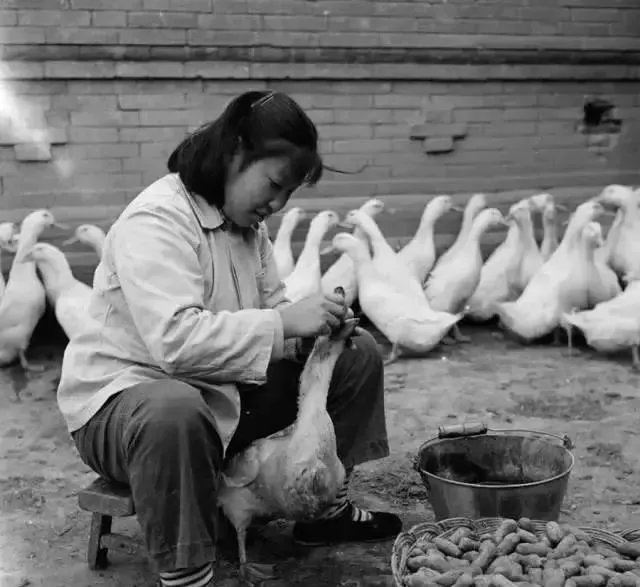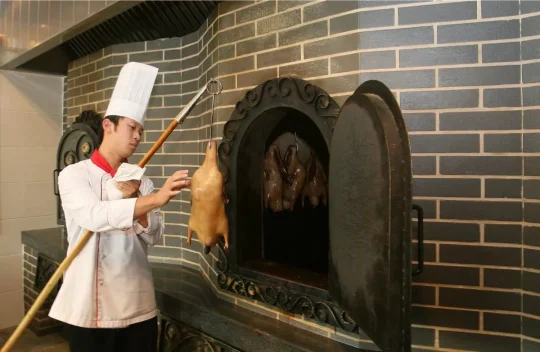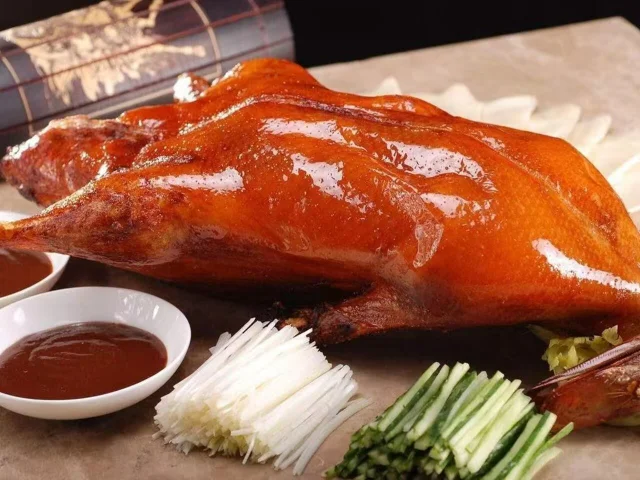Rearing the Duck
Not every duck qualifies to become an honorable Peking duck; it must be a well-bred “Peking stuffed duck” (Beijing Tianya). This breed is developed through a special feeding process involving “dough balls” from sorghum (great millet), black beans, and buckwheat flour, and feeding the ducks manually (modern methods use mechanical injection feeding). The goal is to quickly make the duck plump, tender, and ready for roasting. The rearing cycle for a Peking duck is about 50 days. There’s a saying that ducks gain extra fat in the fall, making autumn the ideal time to enjoy the most succulent and flavorful ducks.

Roasting with Fruitwood
In some traditional restaurants, you might still find Peking duck roasted using real fruitwood. However, not all types of fruitwood are suitable. The hardwood from peach or pear trees works well, but jujube wood is the best. Since ancient times, jujube wood has been highly regarded for this purpose and offers several advantages: it produces light smoke, burns steadily, and provides consistent heat. Even with a large fire, the smoke from jujube wood remains minimal, allowing you to see clearly inside the oven. A few pieces of jujube wood can burn for a long time and the heat from the flames reaches the top of the oven, reflecting down to roast the duck evenly. The natural aroma from the wood infuses into the duck’s skin and meat, making it wonderfully fragrant. Even after sitting for an hour or two, the duck remains aromatic, with a crispy exterior and tender, juicy meat.

Roasting Styles: Open-oven vs. Closed-oven
There are two main ways of cooking Peking duck: open-oven and closed-oven. In the closed oven method, there is no direct flame. The oven is preheated, then the fire is extinguished, and the duck is placed inside with the door closed. The duck is cooked entirely by the residual heat inside the oven. This method preserves fat and moisture, keeping the skin and meat intact. The skin turns out crispy, and the meat remains juicy and flavorful. Traditionally, the closed oven technique was more difficult, as the old masters would rely solely on their experience to judge when the duck was perfectly cooked without ever opening the oven. Today, very few chefs can master this technique.

Closed-oven Style
The open-oven method uses direct flames from smokeless fruitwood and does not have a door. The duck’s position is changed frequently during roasting to ensure it cooks evenly. Because of the open flame, the duck loses fat and moisture more quickly, making the skin extra crispy. However, mastering the heat is crucial. If the heat is not well-controlled, the loss of fat can make the meat dry. Traditionally, fruitwood is used as fuel, giving the duck a crispy skin, tender meat, and a subtle aroma.

Open-oven Style
Slicing the Duck: A Skillful Art
When it comes to Peking duck, 70% of the skill is in the roasting, and 30% is in the slicing. Each chef has their own technique, and mastering the art of slicing takes time and practice. Traditionally, a Peking duck could be sliced into 108, 99, or 90 pieces. In the past, people were frugal and rarely dined out, so when they did, they wanted to get as much meat as possible. Some skilled chefs could slice over 110 pieces, while others could get 90, but, for good luck, the slices were generally referred to as 108. However, after slicing this way, there wasn’t much left of the duck, leaving little fat or flavor for making soup. Also, some parts of the meat didn’t taste very good. So later, the preferred method became to slice the duck into 88 to 90 pieces, leaving the less desirable parts on the carcass.

Peking duck is traditionally served on three plates. The first plate contains slices from the duck breast, with the skin separated from the meat. The second includes slices from the legs, with the skin and meat still attached. And the third contains the halved duck head, two pieces of tender tail, and two premium slices of tenderloin, symbolizing a complete meal “from head to tail.” According to old Beijing tradition, the elder diners would eat the duck head, while the young men would get the tail, as it is the strongest part of the duck. The tenderloin, being the softest meat, was typically reserved for the ladies at the table.
Regardless of the slicing method, speed is key. From slicing to serving should only take 5 to 6 minutes, to ensure the meat stays hot and the skin remains crispy. It’s easy to imagine how the flavor of vacuum-packed meat taken home cannot compare to freshly sliced duck served immediately.
Steamed Pancakes
While the modern age has brought great convenience, it has also led to the decline of handmade delicacies. Today, only a few restaurants still opt for handmade pancakes, which are baked and then steamed to ensure the perfect balance of softness and elasticity. A true premium pancake should be as thin as paper, and when placed on a patterned plate, you should be able to clearly see the design through it.

Sweet Bean Sauce
When eating Peking duck, dipping sauce is essential; without it, the experience is incomplete. The sauce for Peking duck is not soybean paste or fruit jam, but sweet bean sauce. The key to preparing this sauce is to achieve the right balance – not too thick, not too thin. To determine if the sweet bean sauce is made to perfection, there’s a simple test: dip a chopstick or cucumber strip into it and then hold it in the air. If the sauce clings without dripping, it’s considered top-quality.

The Proper Ways to Enjoy Peking Duck
Here are three ways you might eat Peking duck.
1. The thin, shiny duck skin is eaten hot, dipped in a little sugar. This method was said to have originated with the ladies of wealthy households, who didn’t eat onions or garlic but enjoyed the crispy duck skin with fine sugar. Since then, whenever female guests arrive at a Peking duck restaurant, the waiters would automatically serve a small plate of sugar alongside the duck. The crispy skin, combined with the sweetness of the sugar, melts in your mouth, creating a blend of savory and sweet flavors.

2. Serve the duck with sweet bean sauce and strips of green onion, cucumber, and radish. Use chopsticks to spread the sweet bean sauce onto a steamed pancake, place a few slices of duck on top, then add the green onion, cucumber, or radish strips. Roll up the pancake, and it’s a delicious treat.

3. Combine garlic paste with sweet bean sauce, pairing it with radish strips and duck meat, then roll it up in a steamed pancake. This was a popular method in earlier years. The garlic paste cuts through the richness, adding a hint of spice and creating a unique flavor that many diners love.





